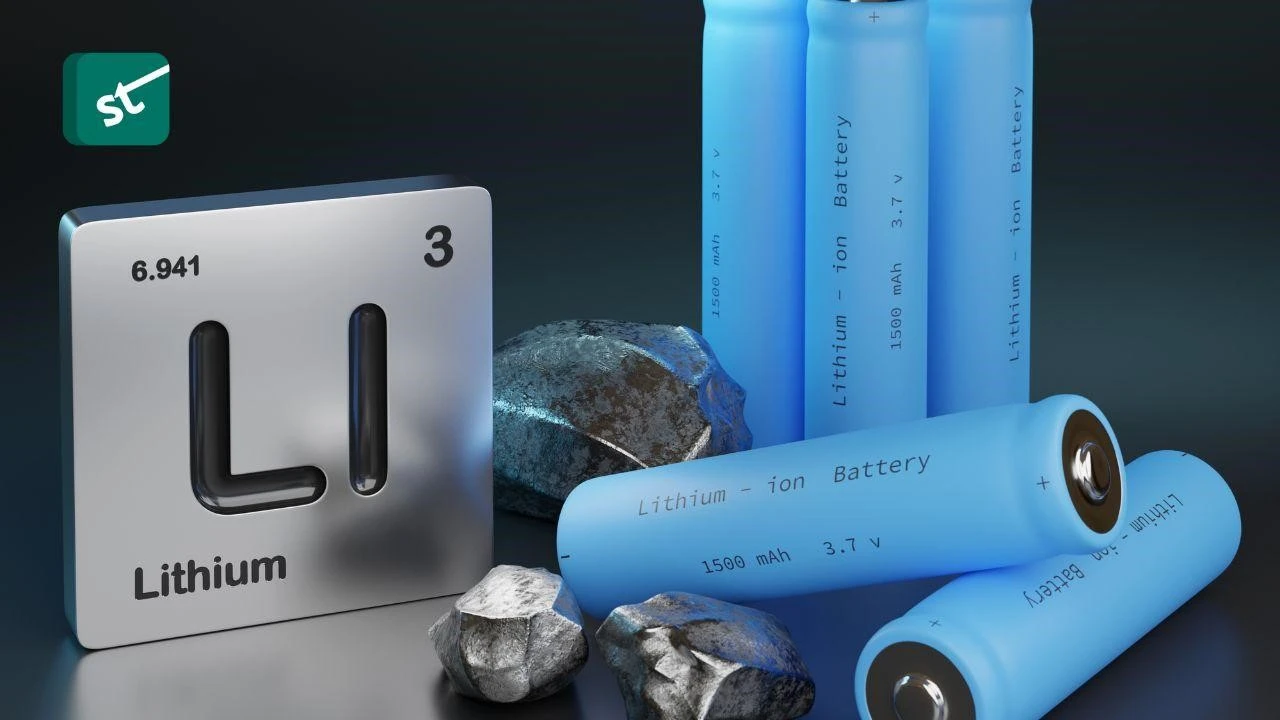Lithium stocks have gained significant attention in recent years due to the growing demand for lithium-ion batteries, which are used in electric vehicles (EVs), renewable energy storage systems, and portable electronic devices.
Lithium is an integral component in the production of rechargeable batteries. Over the past few years, the need for environment-friendly sources of energy has become a requisite.
Lithium is used in batteries that are used for portable devices, such as smartphones and tablets. It is also being used in developing batteries for electric vehicles, which has seen production levels increase greatly since it first began.
Investing in lithium is becoming increasingly popular. Joe Biden reiterates his administration’s commitment to producing 80% of U.S. power via renewable energy by 2030.
That paves the way for lithium mining and production companies, with lithium stocks continuing to grow.
Nearly all commercial battery-based energy solutions make use of lithium compounds. According to the US Geological Survey, more than 70% of the total lithium production in the world is geared towards batteries.
What You Need to Know about Lithium Stocks
-
Importance of Lithium
Lithium is a key component in rechargeable lithium-ion batteries, which are essential for the electrification of transportation and the storage of renewable energy.
As the demand for EVs and renewable energy continues to rise, the demand for lithium is expected to increase.

-
Market Growth
The lithium market has experienced substantial growth in recent years, driven by the adoption of EVs and the expansion of renewable energy projects.
This growth trend is expected to continue as governments and industries focus on reducing carbon emissions and transitioning to cleaner energy sources.
-
Supply and Demand Dynamics
While lithium demand is growing rapidly, there have been concerns about potential supply constraints.
The lithium market is currently dominated by a few major producers, and increasing production to meet the growing demand may take time.
However, many lithium mining projects are underway to expand production capacity.
-
Lithium Mining
Lithium is primarily obtained from two sources: brine deposits and hard rock (spodumene) deposits.
Brine extraction involves pumping lithium-rich underground brine into evaporation ponds, while hard rock mining involves traditional mining and processing methods. Various companies are involved in lithium mining and exploration worldwide.
-
Volatility and Risk
Like any investment, lithium stocks come with their share of risks. The lithium market can be volatile due to factors such as fluctuating lithium prices, geopolitical risks, regulatory changes, and competition.
Investors should carefully research and consider the risks associated with individual companies before investing.
-
Diversification
Investing in lithium stocks can be a way to diversify a portfolio and gain exposure to the growing clean energy sector.
However, it’s important to maintain a well-diversified portfolio by investing in a range of stocks across different sectors and regions to mitigate risks.
-
Industry Outlook
The long-term outlook for the lithium market remains positive.
The demand for lithium is expected to triple by 2025 and increase tenfold by 2030, driven by the transition to EVs and renewable energy storage.
-
Environmental and Social Factors
As lithium mining expands, environmental and social factors surrounding the extraction and processing of lithium are gaining attention.
Sustainable and responsible mining practices, including water management, energy consumption, and community engagement, are becoming increasingly important considerations for investors.
Investing In Lithium Stocks In 2023
A few general considerations to keep in mind when investing in lithium stocks in 2023 include:
-
Research and Due Diligence
Thoroughly research the lithium industry, including supply-demand dynamics, market trends, and company fundamentals.
Analyze the financial statements, growth prospects, competitive positioning, and management teams of individual lithium companies.
-
Industry Outlook
Understand the outlook for the lithium market and its growth potential. Consider factors such as the increasing adoption of electric vehicles, renewable energy storage, and government policies supporting clean energy.
Assess the long-term demand projections for lithium and the potential impact of emerging technologies.

-
Diversification
Consider diversifying your portfolio by investing in multiple lithium companies. This helps spread risk and exposure across different companies within the lithium sector.
-
Risk Assessment
Evaluate the risks associated with investing in lithium stocks, including price volatility, supply-demand imbalances, regulatory changes, and competition. Assess the specific risks and challenges faced by individual companies in the lithium industry.
-
Long-Term Perspective
Investing in lithium stocks may require a long-term perspective. The growth of the lithium market and the adoption of lithium-ion batteries in various applications could take time to fully materialize.
Consider your investment horizon and whether you are comfortable with potential short-term volatility.
-
Consult a Financial Advisor
Consider consulting with a financial advisor who has expertise in the energy or mining sector. They can provide personalized advice and guidance based on your financial goals, risk tolerance, and investment timeframe.
Lithium Stocks Under $4
-
CBAK Energy Technology (NASDAQ: CBAT)
CBAK Energy Technology is a dynamic player in the lithium-ion battery industry, and its strategic location in China positions it advantageously.
The Chinese market for electric vehicles is thriving, with a remarkable year-over-year growth rate of over 150% recorded as of early 2022, and this trend shows no signs of waning.
This robust market growth strongly indicates a continuous surge in the demand for lithium-ion batteries in the foreseeable future.
Recognizing this potential, CBAK has made a significant move by acquiring an ownership stake of over 80% in Hitrans, a financially robust supplier of lithium batteries.
This strategic move allows CBAK to enhance battery production capacity and effectively cater to the expected surge in orders in the coming months.
Furthermore, in collaboration with AZAPA R&D in China, as part of a joint venture between China and Japan, CBAK has forged an agreement to develop tailor-made batteries for electric vehicle control systems.
This strategic partnership demonstrates CBAK’s forward-thinking approach and highlights its commitment to providing customized solutions for the evolving needs of the electric vehicle industry.
With its visionary approach and proactive measures, CBAK stands out as an exceptional choice among lithium stock picks, poised to capitalize on the ever-growing demand for lithium-ion batteries.
-
Aqua Metals (NASDAQ: AQMS)
The multibillion-dollar electric vehicle market could deliver high revenues for lithium miners and companies involved in producing batteries.
However, lithium is also a finite resource that may have a negative environmental impact when disposed of improperly.
Aqua Metals has already foreseen this challenge and has built a business around recycling clean metals — a company whose market could grow by 5% from 2021 to 2030.
In particular, it has developed a patented hydrometallurgical technology that uses room-temperature water to recycle metals that lessen pollution.
This technology could pique the interest of a growing number of sustainable businesses.
However, the business is currently operating at a loss since it focuses significantly on research and development.
In the hopes of seeing steady growth, it has shipped its product and technology to facilities in Asia, where metals recycling is expected to flourish.
As Aqua Metals closes more deals and sells more units, this lithium penny stock could see significant growth in the stock market.
-
Polar Power (NASDAQ: POLA)
Polar Power doesn’t have the best market cap at only $40 million, but it remains a popular choice in the stock market.
First, the over-40-year-old company is slowly transitioning to providing clean energy alternatives and solutions, including designing and selling a lithium-battery system.
Second, Polar Power has a diverse range of products, such as DC generators, a market segment that could be worth over $25 billion by 2029.
Third, its financials are solid, with a 65% year-over-year increase in net sales for the third quarter of 2021 and a 136% increase in gross profit within the same period.
It claimed a backlog of orders worth $11.4 million during the third quarter of 2021, probably due to supply chain issues.
However, as the global economy recovers, the company might finally realize revenues from these this year. Its years of industry experience, strong financials, and mixed portfolio are great reasons to consider investing in this stock.
The following are other lithium stocks that are most attractive:
Name Price Snow Lake Resources (LITM) $2.46 Tearlach Resources (TELHF) $0.09 Pilbara Minerals (PILBF) $3.21 Noram Lithium (NRVTF) $0.48
Major Lithium Mining Companies
There are several major lithium mining companies operating globally. Here are some of the prominent players in the lithium mining industry:
-
Albemarle Corporation (ALB)
Albemarle retains its position as the largest company on the list and holds the title of the world’s largest lithium producer.
The company operates the sole active lithium mine in the U.S., situated in Silver Peak, Nevada. Lithium constitutes the majority of ALB’s revenue, accounting for slightly over 50% of the company’s total.
Over the past year, Albemarle has achieved a remarkable 30.8% growth in sales. Furthermore, there are expectations of a substantial year-over-year increase in EPS, projected to be around 428.2% in 2022.
With a decade of positive earnings growth, Albemarle demonstrates a track record of consistent performance.
Analysts anticipate a 27.6% growth in EPS for the upcoming year. Moreover, they project an average annualized EPS growth of 77.2% over the next five years. Morningstar assigns a financial health grade of B to ALB, reflecting a favorable evaluation.
Having experienced a 5.8% rise over the past year, the stock is currently only 8% below its 52-week high, indicating a relatively strong performance.
-
Sociedad Química y Minera de Chile (SQM)
SQM (Sociedad Química y Minera de Chile) is headquartered in Chile and specializes in harvesting lithium resources from prime deposits in South America, particularly the salt flats of the Atacama Desert.
In addition to lithium, SQM is involved in the production of iodine, potassium, industrial chemicals, and nitrates for fertilizers.
Sales for SQM have experienced a substantial growth rate of 177.7% over the past year, accompanied by a remarkable 519.9% increase in EPS.
Similar growth rates are anticipated for 2022, with industry analysts forecasting a five-year annualized EPS growth of 14.7%.
SQM maintains a solid track record, delivering positive annual EPS figures for over a decade.
However, it is important to note that the company’s quarterly results can be somewhat volatile, and the long-term sustainability of an upward trend is not guaranteed.
According to Morningstar, SQM’s financial health is rated as a B, indicating a sound investment opportunity. The company also offers a dividend, currently yielding 7.6%.
With a 60% increase over the last year, the stock has shown strong performance and currently stands at a 15% decrease from its 52-week high.
-
Piedmont Lithium Inc. (PLL)
Piedmont, a development-stage lithium miner, is in the early stages of developing its resources compared to Lithium Americas.
The company is currently engaged in lithium mining projects in North Carolina and Tennessee in the United States, as well as in Canada and Ghana internationally.
Piedmont expects to commence lithium mining and refining operations in Quebec by 2023 and in Ghana by 2024, followed by Tennessee in 2025 and North Carolina in 2026.
However, the realization of these projections is subject to rigorous local and national permitting reviews.
As of now, PLL has not generated any sales and has reported negative EPS over the past five years. This trend is expected to continue through 2022, but there may be a change in 2023.
Analysts project an EPS of $3.41 per share and estimated sales of $119 million for the year 2023.
-
Livent Corporation (LTHM)
Livent Corp. traces its origins back to the Lithium Company of America in the 1940s.
Presently, Livent operates in Argentina, Canada, and the United States, engaging in lithium mining and refining to produce intermediate materials utilized in the manufacturing of batteries for electric vehicles (EVs) and handheld devices.
Over the past 12 months, Livent has witnessed a notable 55% growth in sales, accompanied by triple-digit EPS growth compared to the previous year.
This year is expected to be the company’s strongest performance since its spin-off from FMC Corp. (FMC) in 2018.
Analysts project a 29% EPS growth for the upcoming year, followed by an average annualized earnings growth of 1% over the next five years.
Livent’s financial health rating from Morningstar is a C, suggesting that its balance sheet may not be the strongest in the industry.
-
FMC Corporation (FMC)
The final stock on the list of the best lithium stocks is FMC. FMC Corporation specializes in the manufacturing and sale of crop management products aimed at enhancing livestock health and pest control.
Lithium serves as a crucial raw material in FMC’s manufacturing process, making it one of the top lithium stocks. The company distributes its products across the Americas, EMEA, and Asia.
FMC has set a target of achieving net-zero greenhouse gas (GHG) emissions by 2035.
To accomplish this, the company will adopt science-based targets aligned to limit the global temperature increase to 1.5°C above pre-industrial levels.
By participating in the Science Based Targets initiative and aligning with the growing emphasis on lithium in the industry and the zero-emission plans of the U.S. government, FMC stock is poised for upward movement.
FMC stock exhibits favorable fundamentals. The demand for environmentally-friendly energy sources has intensified in recent years, making lithium an essential component.
This rising demand for lithium is expected to generate significant growth potential for lithium stocks in the future.
-
Ganfeng Lithium Group Co. Ltd. (GNENF)
Ganfeng Lithium Group stands as the largest lithium metal producer in China.
Setting itself apart from most competitors, Ganfeng operates through a vertically integrated approach, encompassing extraction, processing, battery manufacturing, and battery recycling.
Over the past four quarters, the company has exhibited substantial growth in earnings per share (EPS) and sales, surging by more than 432% and 265% respectively.
Considering its earnings performance thus far this year, Ganfeng is expected to achieve over 100% year-over-year EPS growth in 2022.
Ganfeng has demonstrated three consecutive years of increasing sales and earnings, showcasing its strength in sustained growth. This year is anticipated to mark the fourth year of growth in both categories.
However, Morningstar has assigned the company a financial grade of C, the lowest among the listed stocks. Despite this, Ganfeng still holds some investment potential.
Morningstar evaluates various factors, including financial leverage, balance sheet health, and cash flow statements, to formulate its financial health grade.
The stock has experienced a downtrend since mid-2021, currently trading approximately 45% below its 52-week high.
-
Li-Cycle Holdings Corp. (LICY)
Li-Cycle Holdings entered the industry as a relatively new player with its initial public offering (IPO) in 2021. The company specializes in battery recycling to recover valuable materials, including lithium.
Due to its recent IPO, there needs to be more financial data available for Li-Cycle to analyze.
While the company has achieved a remarkable 102% growth in sales over the past four quarters, its earnings per share (EPS) remain negative, and there are no current projections regarding when profitability will be attained.
Analysts anticipate a sevenfold increase in sales this year compared to the previous year, reaching $127 million from $17 million.
This represents a highly impressive growth rate. However, it’s important to note that Morningstar has assigned the company a financial health rating of C.
-
Lithium Americas (LAC)
Lithium Americas presents an intriguing and speculative opportunity within the industry, currently lacking significant earnings, revenues, or substantial lithium production.
However, there is potential for a transformative shift soon.
The inclusion of LAC in this listing is justified by the company’s ongoing development of the largest known lithium deposit in the United States, situated at the Thacker Pass mine.
While Albemarle currently operates as the sole active lithium mine in the United States, numerous other mining projects are being pursued in both the United States and Canada.
However, many of these endeavors are still far from reaching the production stage.
The Inflation Reduction Act of 2022, introduced by the Biden administration, offers valuable subsidies to support electric vehicle (EV) buyers and manufacturers.
To qualify for these subsidies, EV batteries must incorporate raw materials sourced from North America or countries with trade agreements with the United States.
Consequently, the lithium resources being developed in the United States by companies like LAC and Piedmont Lithium become increasingly valuable.
Considering these factors, it becomes evident that LAC has the potential to emerge as a significant victor in the realm of lithium production.
Although the company has reported negative earnings per share (EPS) and modest revenues for over a decade, analysts are projecting a positive EPS of $1.01 per share in 2023, alongside estimated sales of $307 million.
-
Sigma Lithium (SGML)
Sigma Lithium has set its sights on achieving environmentally sustainable lithium production, with a firm commitment to achieving net-zero emissions by 2024.
The company’s lithium processing plant is poised to utilize 100% renewable energy sources and 100% recycled water, emphasizing its dedication to eco-friendly practices.
When it comes to financial health, Sigma Lithium stands out from the crowd, boasting an impressive A grade from Morningstar.
However, it’s worth noting that the company has yet to generate any sales and has reported negative earnings per share (EPS) for the past five years.
While this trend is expected to persist until the end of 2022, the outlook for 2023 appears more promising for investors. Analysts anticipate a significant upturn with an EPS of $4.23 per share in 2023.
This positive outlook might explain why Sigma Lithium has been the top performer on the list over the past two years, witnessing a remarkable rally of over 1,500%.
Currently, the stock trades approximately 15% below its recent high, showcasing its potential for further growth.
Investment Strategies for Lithium Stocks
When considering investment strategies for lithium stocks, it’s important to note that investing in individual stocks carries risks, and it’s crucial to conduct thorough research and consider your financial situation and risk tolerance.
Here are a few investment strategies to consider when investing in lithium stocks:
-
Long-Term Growth Investing
Given the expected long-term growth in the lithium market, some investors may choose a long-term growth strategy.
This approach involves identifying companies with strong fundamentals, sustainable competitive advantages, and a track record of innovation and growth.
The focus is on holding these stocks for an extended period, allowing the companies to capitalize on the increasing demand for lithium.
-
Diversification
Diversification is a risk management strategy that involves spreading investments across different lithium stocks and potentially other sectors or asset classes.
By diversifying your holdings, you reduce the risk of being overly exposed to any single stock or industry. This strategy allows you to capture opportunities while mitigating potential losses.
-
Sector-Focused ETFs or Mutual Funds
Another approach is to invest in lithium-focused exchange-traded funds (ETFs) or mutual funds.
These funds pool investments from multiple investors and allocate them across a portfolio of lithium-related stocks.
Investing in an ETF or mutual fund can provide diversification within the sector, and they are managed by professionals who conduct research and make investment decisions on behalf of the fund.
-
Value Investing
Value investing involves identifying lithium stocks that are considered undervalued compared to their intrinsic value.
Value investors look for companies with solid fundamentals, strong balance sheets, and growth potential that the market may have overlooked or undervalued.
They seek to buy these stocks at a discount and hold them until the market recognizes their true value.
-
Research and Analysis
Conduct thorough research and analysis on individual lithium companies. Evaluate their financials, production capacity, growth prospects, competitive positioning, and management team.
-
Risk Management
Assess and manage the risks associated with investing in lithium stocks. Stay updated on factors such as lithium price volatility, regulatory changes, geopolitical risks, and environmental considerations.
Consider setting diversification limits, establishing stop-loss orders, or using other risk management tools to protect your investments.

-
Dollar-Cost Averaging
Dollar-cost averaging is an investment strategy that involves investing a fixed amount of money at regular intervals, regardless of the current stock price.
This approach can help mitigate the impact of short-term market fluctuations and allows you to accumulate shares over time.
Risks and Challenges in the Lithium Market
While the lithium market presents significant opportunities, there are also risks and challenges that investors should be aware of. Here are some key risks and challenges in the lithium market:
-
Price Volatility
Lithium prices can be volatile, influenced by factors such as supply-demand dynamics, global economic conditions, technological advancements, and government policies.
Sharp price fluctuations can impact the profitability of lithium mining companies and the value of lithium stocks.
-
Supply Constraints
As the demand for lithium continues to grow, there is a risk of supply constraints.
Expanding lithium production capacity takes time, and there may be challenges in meeting the increasing demand, especially if there are delays in developing new mining projects or disruptions in production.
-
Competition
The lithium market is becoming increasingly competitive as more companies enter the sector. Increased competition may result in downward pressure on prices and profit margins for lithium mining companies.
It’s important to consider a company’s competitive positioning and ability to differentiate itself in the market.
-
Technological Advancements
Rapid technological advancements can impact the lithium market. Improvements in battery technologies, alternative energy storage solutions, or recycling processes may affect the future demand for lithium.
Investing in companies with a focus on innovation and adaptability can help mitigate this risk.
-
Regulatory and Policy Changes
Regulatory and policy changes, both at the national and international levels, can impact the lithium market.
Changes in government regulations related to mining practices, environmental standards, or subsidies for electric vehicles and renewable energy can influence the demand and profitability of lithium companies.
-
Geopolitical Risks
Geopolitical factors, such as trade tensions, political instability, and resource nationalism, can pose risks to the lithium market.
Changes in international trade policies or disruptions in the global supply chain can impact the availability and pricing of lithium.
-
Environmental Concerns
Lithium mining and extraction processes can have environmental impacts, including water usage, potential contamination, and habitat disruption.
Increasing scrutiny and environmental regulations can add operational costs and compliance requirements for lithium mining companies.

-
Technological Uncertainty
The lithium market is evolving rapidly, and there is always a level of uncertainty regarding future technologies and market preferences.
New battery chemistries or energy storage solutions that do not heavily rely on lithium may emerge, potentially impacting the long-term demand for lithium.
Lithium Stock ETFs
There are several exchange-traded funds (ETFs) that focus on lithium and offer exposure to the lithium industry.
These ETFs typically invest in companies involved in lithium mining, exploration, production, or battery technology. Here are a few examples of lithium stock ETFs:
-
Global X Lithium & Battery Tech ETF (LIT)
LIT is one of the most well-known lithium-focused ETFs.
It seeks to track the performance of the Solactive Global Lithium Index, which includes companies involved in lithium mining, exploration, and battery production.
The ETF holds a global portfolio of lithium stocks.
-
Amplify Lithium & Battery Technology ETF (BATT):
BATT aims to track the performance of the EQM Lithium & Battery Technology Index.
It invests in companies involved in the lithium industry, including lithium miners, battery producers, and technology developers. The ETF has a global focus.
-
iShares Global Clean Energy ETF (ICLN):
While not exclusively focused on lithium stocks, ICLN is an ETF that invests in companies within the clean energy sector, including lithium producers and battery manufacturers.
It provides exposure to a broader range of clean energy industries and technologies.
-
ALPS Clean Energy ETF (ACES)
ACES is another clean energy ETF that invests in companies within the renewable energy and clean technology sectors, including lithium and battery-related companies.
It offers exposure to various segments of the clean energy industry.
-
KraneShares Electric Vehicles and Future Mobility ETF (KARS):
KARS is an ETF that focuses on companies involved in the electric vehicle (EV) and future mobility industry, including those involved in lithium mining, battery production, and EV components.
It provides exposure to the broader theme of EVs and sustainable transportation.
Hydrogen vs. Lithium Stocks: Which Is Best?
Comparing hydrogen stocks and lithium stocks is a complex task as they represent different segments of the clean energy and transportation sectors.
Here are some key factors to consider when comparing hydrogen and lithium stocks:
-
Market Potential
Both hydrogen and lithium are expected to play significant roles in the transition to a cleaner energy future.
Hydrogen is viewed as a potential energy carrier for various applications, including transportation, industry, and energy storage.
Lithium, on the other hand, is a critical component in lithium-ion batteries used in electric vehicles and renewable energy storage.
The market potential for both sectors is substantial, but the timing and scale of their adoption may differ.
-
Technology and Infrastructure Maturity
The lithium-ion battery technology is more mature and commercially established compared to hydrogen fuel cell technology.
Electric vehicles powered by lithium-ion batteries are already in widespread use, while the deployment of hydrogen fuel cell vehicles and infrastructure is still relatively limited.
The maturity of lithium technology provides some certainty and visibility in terms of market adoption and growth.
-
Regulatory and Policy Support
Government policies and regulations play a crucial role in the adoption and growth of clean energy technologies.
Both the hydrogen and lithium sectors are subject to government support and incentives.
However, the level of policy support and focus may vary between countries and regions.
It’s important to consider the regulatory environment and government initiatives when evaluating investment opportunities in either sector.

-
Supply Chain and Infrastructure
The supply chain dynamics differ for hydrogen and lithium. Lithium production relies on mining and processing lithium ore, while hydrogen production involves various methods such as electrolysis, reforming natural gas, or biomass gasification.
The infrastructure requirements for hydrogen, including production, storage, and refueling stations, are more complex and expensive compared to the charging infrastructure needed for electric vehicles.
-
Investment Risks and Volatility
Investing in both hydrogen and lithium stocks carries risks. Hydrogen stocks may be subject to technology and infrastructure development challenges, market adoption uncertainties, and competition from other clean energy solutions.
Lithium stocks face risks related to lithium price volatility, supply-demand dynamics, and technological advancements.
It’s important to carefully assess the risks and conduct thorough research on individual companies before making investment decisions.
-
Portfolio Diversification
Including both hydrogen and lithium stocks in a diversified portfolio can offer exposure to different segments of the clean energy and transportation sectors.
This diversification can help reduce risk by spreading investments across multiple industries and technologies.
Conclusion
In conclusion, the best lithium stocks for long-term growth present compelling investment opportunities in a rapidly expanding industry.
As the demand for lithium-ion batteries continues to surge, driven by the rise of electric vehicles and renewable energy storage, these stocks have positioned themselves to capitalize on the trend.
From established players with strong track records to innovative companies pushing the boundaries of sustainable lithium production, each stock offers unique strengths and growth prospects.
Investors should carefully consider factors such as financial health, market positioning, and sustainability practices when selecting the best lithium stocks to include in their long-term investment portfolios.
With diligent research and a forward-looking mindset, investors can potentially benefit from the promising future of the lithium industry.
Frequently Asked Question
How Can I Invest in Lithium Stocks?
To invest in lithium stocks, you can follow these steps:
- Open A Brokerage Account: Choose a reputable online brokerage platform that offers access to the stock market.
- Research Lithium Stocks: Conduct thorough research on lithium mining companies, battery manufacturers, and other related companies involved in the lithium industry.
- Select Specific Stocks: Choose the individual lithium stocks you want to invest in based on your research and investment objectives.
- Fund Your Brokerage Account: Deposit funds into your brokerage account to have capital available for investing.
- Place Your Trades: Use your brokerage platform to place buy orders for the selected lithium stocks. Specify the number of shares you want to purchase and the price you are willing to buy.
- Monitor And Manage Your Investments: Keep track of your lithium stocks’ performance and stay informed about industry trends, news, and company updates. Consider setting up alerts or stop-loss orders to manage risk.










